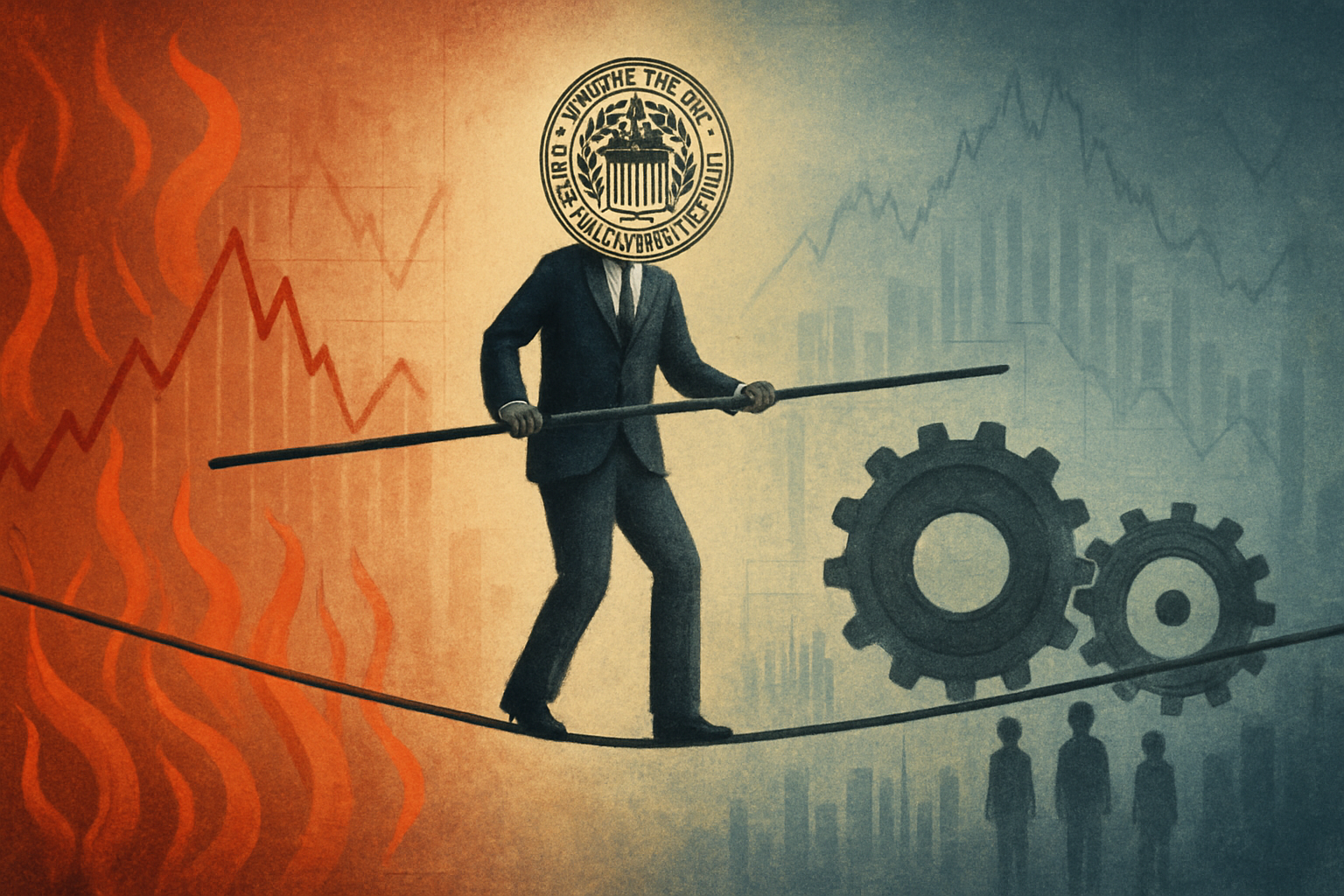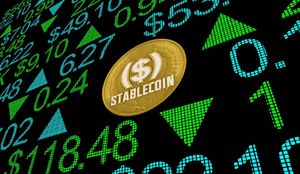Financial News
The Fed's Tightrope Walk: Persistent Inflation Meets a Softening Job Market as Rate Cuts Begin

Washington D.C., October 9, 2025 – The Federal Reserve finds itself navigating an increasingly complex economic landscape, attempting a delicate balancing act between taming stubbornly persistent inflation and responding to a visibly softening labor market. As of October 202025, the central bank has initiated a new cycle of interest rate reductions, a significant pivot from its aggressive tightening campaign, yet inflationary pressures continue to loom large, casting a shadow of uncertainty over future policy decisions.
This pivotal moment sees the Fed, under Chair Jerome Powell, grappling with the dual mandate of achieving maximum employment and price stability. While recent data points to a cooling job market, providing some impetus for easing monetary policy, the specter of inflation, which has lingered above the Fed's 2% target for an extended period, demands continued vigilance. The market is now keenly watching how this "reluctant dove" Fed will manage these conflicting forces.
A Challenging Economic Confluence: Inflation's Grip and Labor's Retreat
The period from late 2024 through the third quarter of 2025 has been marked by a challenging economic confluence: inflation proving more resilient than anticipated, even as the once-robust U.S. labor market shows clear signs of deceleration. This dynamic has forced the Federal Open Market Committee (FOMC) to recalibrate its strategy.
Inflation, as measured by the 12-month core Personal Consumption Expenditures (PCE) price index, closed 2024 at 2.8%, showing only a marginal decline from 3.0% at the end of 2023. Early 2025 saw stronger-than-expected inflation figures, a pattern observed in previous years, potentially due to annual price adjustments by firms. By July and August 2025, headline Consumer Price Index (CPI) inflation had climbed to 2.7% and 2.9% year-over-year respectively, with core CPI remaining at a concerning 3.1%. Factors like tariffs, explicitly acknowledged by Fed Chair Powell, have been cited as contributing to these elevated price levels, delaying the return to the 2% target. Some Fed officials have even voiced concerns about higher inflation becoming a "permanent phenomenon."
In response to earlier inflationary surges, the Fed had embarked on a series of interest rate reductions starting in September 2024, lowering the federal funds rate from 5.5% to 4.5%. However, after a pause, the central bank maintained rates at 4.5% through March 2025, even as it revised its economic projections to forecast slower GDP growth (1.7% from 2.1%) and higher core inflation (2.8% from 2.5%) for 2025. The language in FOMC statements shifted, reflecting increased uncertainty around the economic outlook.
The most significant policy pivot came in September 2025, when the Fed implemented its first interest rate cut of the year, bringing the federal funds rate to a range of 4.00%-4.25%. This move was largely driven by a "shift in the balance of risks" towards labor market weakness. The updated "dot plot" indicated expectations for 50 basis points of additional cuts this year. Yet, FOMC minutes released in October revealed that "a majority of participants emphasized upside risks to their outlooks for inflation," highlighting deep-seated caution among policymakers.
Concurrently, the U.S. job market has softened considerably. Revised data indicated that 911,000 fewer jobs were added in the year ending March 2025 than initially estimated. Average monthly nonfarm payroll gains plummeted from 168,000 in 2024 to a mere 30,000 during the three months through August 2025. The unemployment rate, after holding steady for much of the preceding year, rose to 4.2% in July and 4.3% in August 2025. Wage growth has moderated, suggesting it is no longer a primary driver of inflation. Chair Powell himself noted a "less dynamic and somewhat softer labor market" in September, acknowledging the growing downside risks to employment.
This challenging environment underscores the Fed's data-dependent approach, with future policy adjustments contingent on incoming economic data, particularly inflation readings and labor market reports. The central bank's commitment to its dual mandate remains firm, but the path to achieving both maximum employment and price stability has become increasingly fraught with complexities.
Market Winners and Losers in a Shifting Economic Tide
The unique economic blend of persistent inflation, a softening labor market, and a Federal Reserve initiating interest rate cuts in October 2025 creates a distinct landscape of winners and losers across various public companies. The ability to manage costs, maintain pricing power, and leverage cheaper financing will largely determine corporate performance.
Companies Positioned to Win:
Firms with strong pricing power are particularly well-insulated against persistent inflation. Consumer staples giants like The Hershey Company (NYSE: HSY) and Procter & Gamble (NYSE: PG) are expected to fare well due to inelastic demand for their essential products, allowing them to pass on increased input costs to consumers. Similarly, specialized sectors like life sciences tools, exemplified by Thermo Fisher Scientific (NYSE: TMO), and healthcare services, such as UnitedHealth Group (NYSE: UNH), often possess strong pricing power due to the critical nature of their offerings. Even certain quick-service restaurants like Chipotle Mexican Grill (NYSE: CMG) and technology behemoths like Apple (NASDAQ: AAPL), with their strong brand loyalty and perceived value, can maintain pricing power.
The pivot to lower interest rates is a boon for capital-intensive industries and growth-oriented companies. Real Estate Investment Trusts (REITs) like Prologis (NYSE: PLD) and American Tower Corporation (NYSE: AMT) will see reduced financing expenses, boosting profitability and enabling further investment. Utilities, such as NextEra Energy (NYSE: NEE), also benefit from cheaper borrowing for their extensive infrastructure projects. Homebuilders like D.R. Horton (NYSE: DHI) and Lennar (NYSE: LEN) are poised to gain from lower mortgage rates stimulating housing demand, despite lingering inflation in construction materials. Growth technology companies, including Nvidia Corp. (NASDAQ: NVDA), Microsoft (NASDAQ: MSFT), and Amazon (NASDAQ: AMZN), which often rely on debt for innovation and expansion, will find their borrowing costs reduced, making future earnings more valuable and potentially boosting valuations. Furthermore, the robust business investment in AI-related technologies continues to benefit companies like Microsoft (NASDAQ: MSFT) and Nvidia Corp. (NASDAQ: NVDA), which are at the forefront of providing AI infrastructure and services.
Companies Facing Headwinds:
Conversely, companies with limited pricing power or high sensitivity to input costs are likely to struggle. Certain lower-tier food producers or manufacturers with thin margins, lacking dominant brand recognition, will find it difficult to pass on rising raw material and labor costs, leading to squeezed profit margins. Energy companies like Exxon Mobil (NYSE: XOM) could face headwinds from volatile commodity prices and uncertain global demand, impacting their earnings and revenues.
Sectors heavily reliant on discretionary consumer spending are also vulnerable. A softening job market, combined with persistent inflation eroding purchasing power, typically leads consumers to cut back on non-essential items. Airlines such as American Airlines Group (NASDAQ: AAL) and satellite TV providers like Dish Network Corporation (NASDAQ: DISH) may experience reduced demand as consumers tighten their belts. While a broader economic boost from rate cuts could benefit some retailers, those specializing in luxury goods or operating with thin margins, like some in the Consumer Discretionary sector, might struggle if job market concerns outweigh the benefits of cheaper credit.
Financial institutions, particularly regional banks and lenders heavily reliant on net interest margin, could see their profitability squeezed as interest rates decline. If lending rates fall faster than deposit rates, their core business model is challenged. Finally, companies with high labor costs and limited pricing power, such as logistics and freight firms like FedEx Corporation (NYSE: FDX) and J.B. Hunt Transport Services (NASDAQ: JBHT), will continue to contend with elevated operational expenses that are difficult to fully offset through price increases, especially in a slowing economy.
Wider Implications: A Fragmented Global Economic Landscape
The Federal Reserve's current "reluctant dove" stance—initiating rate cuts while remaining deeply concerned about persistent inflation—is not merely a domestic policy shift; it reverberates across the global economy, intersecting with complex geopolitical realities, fragmented supply chains, and diverging fiscal policies. This creates a highly uncertain and potentially volatile environment for industries and nations alike.
A key broader trend is the continued disruption of global supply chains, which, contrary to earlier expectations of normalization, are now seen as facing "structural realities" of tariff volatility, labor pressures, and fractured trade flows. Inventories built up to front-run tariff deadlines are depleting, forcing companies to restock at higher prices. This translates into rising supply chain costs—projected to increase as much as 7% above base inflation by late 2025—which squeeze profit margins and compel retailers to consider further price hikes. The embrace of technology, particularly AI, is increasingly viewed as a strategic imperative for businesses to mitigate these inflationary pressures and enhance productivity.
Geopolitical risks are no longer peripheral but central to economic forecasting in October 2025. Ongoing conflicts, such as the Russia-Ukraine and Israel-Hamas wars, continue to fuel regional instability, impacting energy and food security, and contributing to global inflationary pressures. Critically, US-China relations, marked by escalating tariffs—with the U.S. effective tariff rate climbing to approximately 17% in 2025 from 2.3% in 2024—are profoundly influencing trade patterns and increasing costs. These tensions disrupt cross-border trade, curb investment, and hurt asset prices, particularly affecting financial institutions and lending in emerging market economies.
The U.S. fiscal trajectory also presents significant wider implications. With public debt projected to exceed 135% of GDP by 2030, the sustainability of U.S. finances is under scrutiny, threatening both domestic and global economic stability through fiscal spillovers. Expansive fiscal policies, including tax cuts and infrastructure investments, combined with increased tariffs, are expected to fuel inflation and potentially lead to trade wars and job losses. This aggressive fiscal stance, alongside rising interest expenses, adds another layer of inflationary pressure, even as the Fed attempts to ease monetary policy. Globally, divergent fiscal policies are fragmenting the international investment picture, with some nations pursuing stimulus while others face austerity.
These dynamics create significant ripple effects. Global growth is decelerating, with projections for 2025 downgraded across most emerging market and developing economies. Heightened trade barriers and policy uncertainty, largely driven by increased U.S. tariffs, are worsening the environment for international trade and are expected to generate global inflationary pressures while slowing economic growth. A strong U.S. dollar, a common outcome of higher interest rates (even if now easing), makes dollar-denominated goods more expensive for countries using other currencies, suppressing demand in emerging markets. Many emerging economies, reliant on dollar-denominated borrowing, face increased repayment burdens and heightened risks of financial instability, including capital outflows and currency destabilization.
Regulatory implications extend beyond the Fed. The legality and economic wisdom of the significantly increased tariffs are a subject of intense debate, with some economists warning of a potential recession and Supreme Court challenges. There's a growing call for greater fiscal responsibility, including discussions on entitlement programs and streamlining regulations to encourage private sector investment. Furthermore, geopolitical rivalries are contributing to an increasingly fragmented regulatory environment, especially for financial services, demanding greater compliance from companies operating across different geographies.
Historically, the current situation evokes comparisons to the challenging "stagflation" of the 1970s—a period of slower growth, higher unemployment, and rising inflation. This comparison is particularly unsettling given that a weak economy typically helps contain inflation, making the current divergence difficult for policymakers. The projection that core PCE inflation may not return to the Fed's 2% target until the end of 2027 would mark the longest period of above-target inflation since a seven-year stretch ending in 1993, underscoring the deep-seated nature of current inflationary pressures. The Fed's "reluctant dove" stance is a direct consequence of these contradictory signals, leading to internal divisions within the FOMC and an elevated sense of uncertainty regarding the future path and pace of rate cuts. This delicate balance means monetary policy will likely be characterized by careful, perhaps slower-than-market-expected, adjustments, with any further uptick in inflation potentially derailing future easing.
What Comes Next: Navigating an Uncharted Path
The path forward for the U.S. economy and financial markets, as of October 2025, is fraught with both opportunity and peril, largely dictated by the delicate balance the Federal Reserve maintains between persistent inflation and a softening job market. The Fed's "reluctant dove" stance signals a cautious easing cycle, but the ultimate trajectory remains highly data-dependent.
In the short-term (late 2025 - early 2026), markets anticipate further 25 basis point rate cuts in October and December 2025, potentially bringing the federal funds rate into the 3.50%-3.75% range by year-end. This easing is expected to support modest economic growth, projected around 1.6%-1.9% for 2025. However, consumer spending growth is likely to slow due to the cooling labor market and renewed inflationary pressures, even as AI-related business investment continues to be a tailwind. Financial markets are likely to remain volatile, as the divergence between market expectations for aggressive cuts and the Fed's cautious approach creates uncertainty. While initial stock market responses to rate reductions may be positive, concerns about sticky inflation and the potential for a "growth scare" will keep investors on edge. A weakening U.S. dollar, a common outcome of earlier rate cuts, could make American exports more competitive but imports more expensive.
Looking into the long-term (beyond 2026), the expectation is for inflation to eventually normalize, with projections suggesting a return to the Fed's 2% target by late 2027 or 2028. If this materializes, the Fed could continue its easing cycle, potentially bringing the federal funds rate to a more neutral range of 3.25%-3.5%. However, the risk of a recession in late 2026 looms if high tariffs and interest rates erode purchasing power and lead to higher unemployment. Conversely, continued strong business investment in AI is expected to be a significant driver of economic activity for years to come.
For businesses, strategic pivots are essential. Lower borrowing costs encourage debt refinancing and expansion, allowing for new projects and improved cash flow. Companies must remain adaptable to evolving consumer demand and proactively manage supply chains to mitigate ongoing tariff uncertainties and cost increases. A focus on efficiency and technological adoption, particularly AI, will be crucial to reduce inflationary pressures and enhance productivity.
Investors are advised to adopt flexible strategies, balancing equities and fixed-income exposure. Gold, long-duration bonds, growth and AI stocks (like Nvidia Corp. (NASDAQ: NVDA) and Microsoft (NASDAQ: MSFT)), small-cap stocks, and rate-sensitive sectors such as homebuilders (D.R. Horton (NYSE: DHI), Lennar (NYSE: LEN)) and REITs (Prologis (NYSE: PLD), American Tower Corporation (NYSE: AMT)) are seen as immediate beneficiaries of Fed rate cuts. However, a diversified approach with robust risk management tools is prudent. A weakening U.S. dollar could also make higher-yielding emerging markets more attractive, potentially leading to increased capital inflows and outperformance for emerging market equities, particularly in Asia. Investors must closely monitor core inflation, labor market resilience, and any shifts in the Fed's communication.
Several potential scenarios could unfold:
- "Soft Landing" (Baseline): The Fed successfully navigates the economic currents, achieving a gradual reduction in inflation without triggering a severe recession, while supporting the labor market.
- "Growth Scare": The economy slows more sharply than anticipated, forcing the Fed to cut rates more aggressively, signaling deeper underlying economic weakness.
- Persistent Stagflation/Higher for Longer Inflation: Inflation proves stickier than expected, perhaps due to continued tariff effects or supply shocks, compelling the Fed to pause or even reverse rate cuts in late 2026, leading to a prolonged period of elevated rates and slower growth.
- Overheating Economy (Unlikely): Aggressive rate cuts in a resilient economy lead to excessive debt-taking and spending, reigniting inflationary pressures.
- Government Shutdown Impact: A prolonged U.S. government shutdown, as seen in October 2025, could delay crucial economic data, forcing the Fed to make decisions in a "data vacuum," potentially increasing market volatility or necessitating more aggressive rate cuts to offset economic losses.
The Fed's "reluctant dove" stance encapsulates this uncertainty, signifying a central bank willing to support employment but deeply cautious about reigniting inflation. This delicate balance means monetary policy will likely be characterized by careful, perhaps slower-than-market-expected, rate adjustments, with any further uptick in inflation potentially derailing future easing.
Comprehensive Wrap-up: A New Era of Economic Vigilance
The U.S. economy in October 2025 stands at a critical juncture, defined by the persistent challenge of stubborn inflation and a visibly softening job market. The Federal Reserve's response, characterized by its "reluctant dove" posture and the initiation of interest rate cuts, marks a significant pivot in monetary policy, yet it is a strategy fraught with inherent tensions and uncertainties.
The key takeaways are clear: inflation, exacerbated by factors like tariffs and ongoing supply chain disruptions, has proven more resilient than anticipated, remaining above the Fed's 2% target. Simultaneously, the labor market, once a beacon of strength, is showing undeniable signs of cooling, with job growth slowing and unemployment edging upwards. This dual challenge forces the Fed into a precarious balancing act, attempting to support employment without re-igniting price pressures. The September 2025 rate cut signals a lean towards supporting the job market, but internal FOMC minutes reveal deep-seated concerns about inflation, suggesting a cautious and data-dependent approach to future easing.
Moving forward, the market will remain highly sensitive to incoming economic data, particularly inflation readings and labor market reports. Investors should anticipate continued volatility as the Fed navigates this complex environment, potentially leading to a "soft landing" where inflation gradually subsides without a severe recession, or a "growth scare" if the economy slows more sharply. The risk of prolonged "higher for longer" inflation or even a return to stagflation, reminiscent of the 1970s, cannot be entirely discounted given the current confluence of factors.
For investors in the coming months, vigilance is paramount. Diversified portfolios that can adapt to both inflationary pressures and moderating growth will be crucial. Opportunities may emerge in companies with strong pricing power and those that benefit from lower borrowing costs, such as certain consumer staples, healthcare, technology, utilities, and homebuilders. Conversely, highly discretionary sectors and some financial institutions may face headwinds. Geopolitical developments, particularly trade policies and conflicts, will continue to exert significant influence on global supply chains and inflation. The Fed's communication, the trajectory of core inflation, and the resilience of the labor market will be the critical indicators to watch as this new chapter of economic policy unfolds.
This content is intended for informational purposes only and is not financial advice
More News
View More




Recent Quotes
View More
Quotes delayed at least 20 minutes.
By accessing this page, you agree to the Privacy Policy and Terms Of Service.



